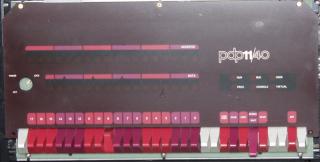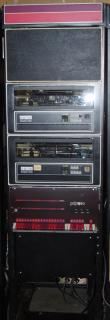PDP-11/40
This was the model of PDP-11 that I used the most while in school so as
to make my nostalgic collection complete I needed to have one. It
was fairly complete (although missing a few cosmetic features) it's
functional state was unknown.


When I got it home, the first thing to do was to put it (and its power
supply) in a rack. I planned on using RK05's as the mass storage
for this system so I also put two of the drives that I acquired with
the PDP-8/e into the rack with the 11/40.
It was missing system units, so I filled the BA11-F with 2 DD11-CFs,
2 DD11-DFs and an RK11-D. This system will take a lot of cards
before it is full!
I checked all of the power supply voltages and they all looked fine.
The problem is that the system is "frozen". Nothing works.
A few LEDs on the front panel lite, but that's all. None of
the switches on the front panel cause any noticable change in the
system. It looks like there will have to be a fair amount of
debugging to get this beast going.
5/17/2003 Update
I removed all of the peripheral and memory cards that I had plugged
into the various backplanes and put an M930 terminator in the first
DD11-CF backplane to make the UNIBUS as short as possible. That
didn't help much.
I re-checked all of the voltages and they all looked fine. On a
hunch, I checked the ACLO and DCLO signals going into the processor.
They were both low. Well, that seemed like a problem! I
traced back to the power distribution board and the signals were low
there too. To see if this was the problem I pulled the connector from
the power distribution board to the CPU backplane (since it didn't have
any power on that connector) and re-applied power.
I could now do a load address (doesn't load the right address though).
If I repeatedly hit the EXAM button, the address increments (the
data is all 1's since there's no memory plugged in). So this is
definetly progress. I don't have any more time to work on it, but
the next thing is to see why ACLO and DCLO are not being de-asserted
(they are active low signals). The weird behavior of load address
*may* be due to the fact that not all of the circuits in the CPU are
being reset properly. I could try and fake something up, but
it'll probably be easier to figure out why these signals aren't being
driven properly (which I have to do anyway).
8/2/2003 Update
I did a fair amount of checking on the 11/40 today. It appears
that the ACLO and DCLO from the power supply are not being driven when
the voltages reach their proper levels. I guess I'll have to dig
into it and figure out what the problem there is. Hopefully it
will be fairly straight forward.
With the connector that supplies ACLO, DCLO and the 60Hz clock removed,
I could do a bit more diagnosis of the basic CPU. In doing so, I
discovered that when I do a load address, bit-7 is stuck on.
However if I repeatedly hit EXAM and watch the address increment, it
clears at the appropriate time. This seems like a bit in the load
address path is stuck. I also noticed that bit-8 of the address
never lights. Neither setting it with a load address nor
incrementing the address would cause the LED to light. After
messing about, I determined that it was a bad LED and once replaced, it
worked fine.
I went back to try and figure out the stuck bit when I did a load
address. Hoping it might be something easy (like a non-functional
switch) I checked out all of the switches on the front panel.
Nope, that wasn't it. I'll have to dig into the CPU now to figure
this one out.

